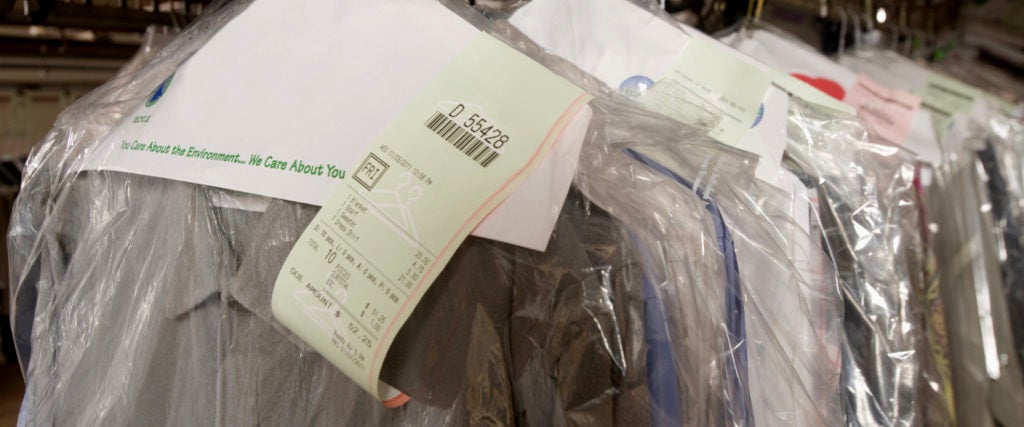I recently moved less than two miles away from my old apartment. It was far enough, though, that I decided to switch to a cleaners that’s only about a block from my new place. It was, relatively speaking, a costly decision. Because when I went to drop off a shirt to be dry-cleaned, the woman behind the counter told me she charges $5 per button-down, a dollar more than I’d been paying previously.
It turns out I’m lucky it wasn’t even more. According to a 2017 piece in the Washington Post, the difference in the price to launder a cotton dress shirt can range from 99 cents to nearly six bucks. “To dry-clean a man’s two-piece wool suit, the range was from $1.99 to $49,” it added.
Rent, of course, is a factor here. But that notwithstanding, how can the cost of dry cleaning the same item of clothing differ so much from place to place, including those that are only a couple miles apart (and ostensibly paying similar real-estate costs)? Don’t they all use the same machines, the same chemicals and the same processes?
Let’s press on for some answers…
What Goes into the Cleaning Process
“About a decade ago, most dry cleaners switched from PERC to hydrocarbon solvents,” explains Hamlet, who owns his own dry-cleaning company in L.A. and has been in the business for more than 20 years. The switch mainly occurred because the EPA labeled PERC a probable carcinogen that could cause severe health problems.
The price of these new(ish) solvents, however, can be fairly volatile. Hayk, the owner of Hollywood Dry Cleaners in L.A., tells me that a 55-gallon container is the industry standard. “But the price is always different,” he says. “It depends on the supplier, who sometimes charges $600, but other times charges $1,000.” He compares how this amount is passed down to the consumer to the cost of a Red Bull at a CVS versus a liquor store. “At CVS, a Red Bull is $3; in liquor stores, it’s sometimes $4 to $5,” he says. “Everyone can set their own price.”
Hamlet adds that the price might also differ based on how much a plant charges other dry cleaners to use their equipment. “Most dry cleaners send their shirts to plants to be machine-pressed,” he says, explaining that on-site machinery is a rarity.
What Goes into Running a Dry Cleaners
Interestingly, both Hamlet and Hayk tell me that cleaners with their own plant typically charge more than those without one. “We have to pay for all the solvents, all the staff for the plant and all the good managers to make sure the plant is running well,” Hayk says. On the flip side, dry cleaners who outsource their business to third-party plants mostly only have a couple of ongoing expenses — rent and the water and power bill. (In fairness, there is about 50k in startup costs — the mechanical rack that rotates finished clothing being the big one.)
In terms of rent, again, it’s pretty obvious that cleaners in cities like New York and L.A. (where I’m based) are gonna be more expensive than in areas with cheaper real estate. “Rent goes up three percent every year,” says Hamlet, whose prices rise with it.
What Goes into Each Article of Clothing
For the most part, there is some consistency among specific articles of clothing — e.g., a men’s button-down shirt is almost always going to be the least expensive item.
Button-Down Shirts. “The cost can increase by a few dollars depending on the fabric of the shirt,” says Hamlet, who charges $3.50 per standard men’s button-down. “If it’s linen or silk, it’ll be $4.50 because it needs to be hand-pressed by an individual and that can take anywhere from five to seven minutes.”
Pants. Along those lines, the type of material can affect the cost of dry-cleaning a pair of pants, too. “Leather pants will cost more to clean than polyester pants,” Hamlet explains. He says that there’s an industry “secret” with regard to dry-cleaning leather that he can’t reveal, but he tells me that it’s incredibly time-consuming and requires the use of expensive chemicals that have to be applied by hand. “It can take one person 30 minutes sometimes to clean leather the way it should be cleaned,” he adds.
Suits. “I charge $15.75 for any two-piece suit set,” says Hamlet. “It has to be ironed by hand so it takes a lot of time to do right.” Alternatively, Hayk charges $18.99. His rationale pretty much says it all: “I have a lot of staff — and a lot of expenses. It’s not the most expensive price, but it’s also not the least. It’s the price we think it takes to do the job right.”

